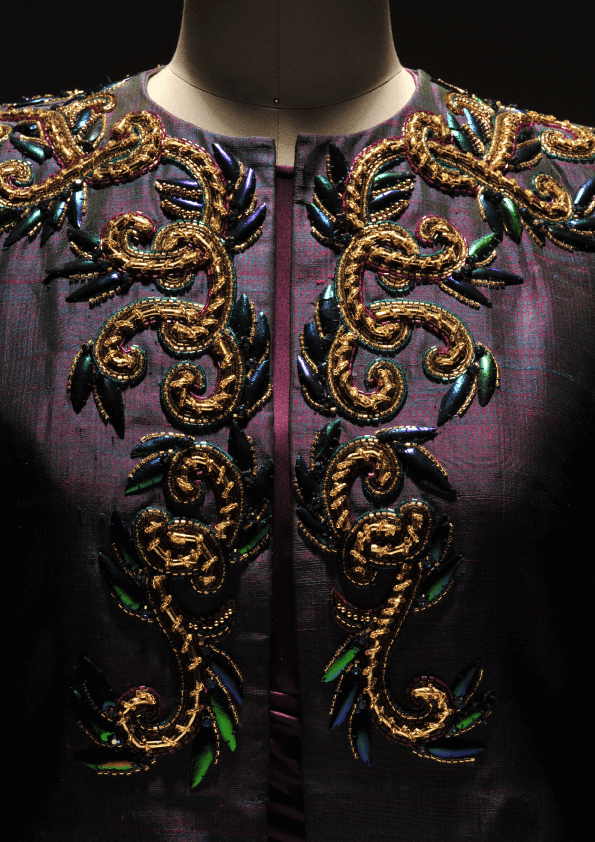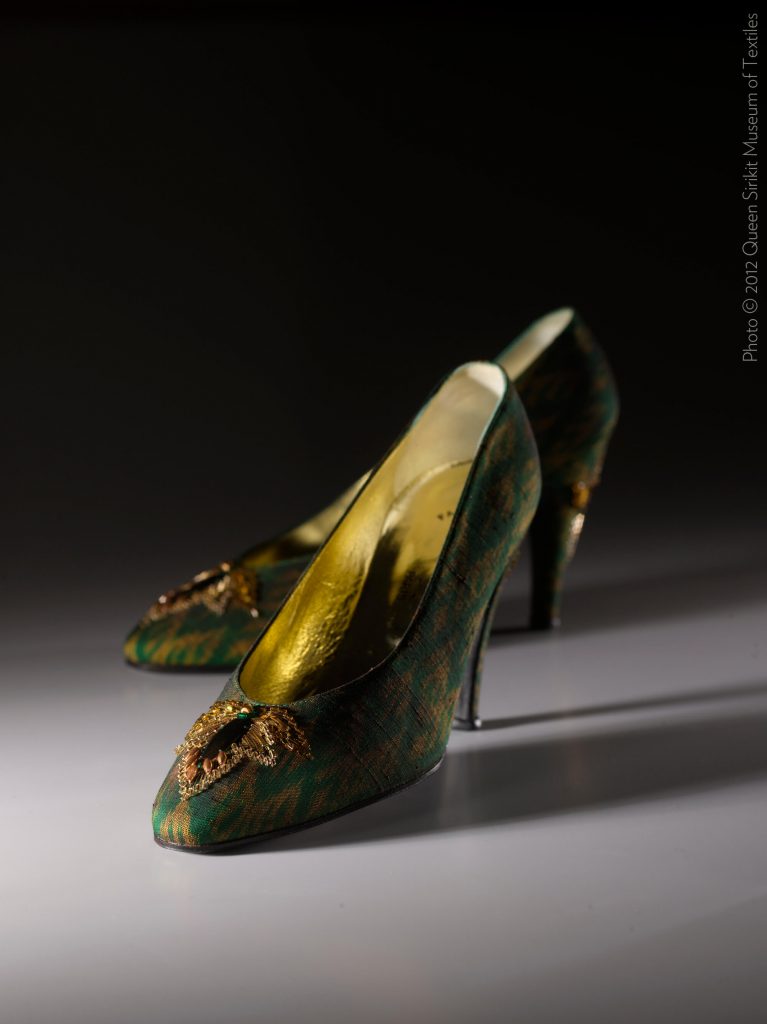Beetle-Wing Embroidery

[photo cr. Queen Sirikit Museum of Textiles]
Jewel beetles – called malaengthap (แมลงทับ) in Thai – have long been prized for their spectacular colors and glossy, enamel-like forewings, called elytra, which form a hard, protective shield for the hind winds used for flight. Evidence dating to the late 18th century suggests that beetle-wing embroidery, long a tradition in India, was also popular at the Thai court, where it was used to decorate accessories such as shoulder cloths and waist sashes. Over time, however, the popularity of beetle-wing embroidery declined.
Revitalization
During Her Majesty Queen Sirikit’s visits to Northeast Thailand, villagers would often present gifts of entire beetles or their shimmering, blue-green wings to Her. Her Majesty, then, had one beetle made into a brooch but did not otherwise utilize them at first. However, in 1982, at the time of Bangkok’s bicentenary celebrations, Her Majesty discovered a silk shoulder sash embroidered with still-beautiful beetle wings that had belonged to the late Queen Savang Vadhana, a consort of King Rama V (r.1868-1910). Her discovery, and the memory of all the beetle wings She received from villagers, led Her to decide to revive the art of beetle-wing embroidery.
A training program was introduced at the workshop of the SUPPORT Foundation – an organization established by Her Majesty to preserve traditional crafts and create jobs – at Chitralada Villa in Bangkok and at two other palace workshops in the North and Northeastern region. At these centers, craftspeople are taught to embroider with beetle wings and to incorporate into fern vine basketry. Examples of the best of this work are now on display at the Arts of the Kingdom Museum in Ayutthaya province.

Details of Her Majesty’s Dress [photo cr. Queen Sirikit Museum of Textiles]
Since its comeback, beetle-wing embroidery has graced many of the ensembles Her Majesty Queen Sirikit has worn on formal and state occasions. Designers and embroiderers such as Balmain and Lesage in Paris and Tirapan in Bangkok, have developed their own methods of incorporating beetle wings into the decoration of Her Majesty’s clothing. Today, the material is used for clothing, jewelry, accessories, and even furniture.
Jewel Beetle Conservation
Jewel beetles are commonly found in the Northeastern region of Thailand. The beetles, with a life cycle of about four weeks, are allowed to die naturally before their wings are harvested. As a result of Her Majesty’s endeavor, the demand for the material increased, and Her Majesty became concerned that jewel beetles might become endangered in the country. This led to royal support for research undertaken at Kasetsart University into beetle conservation, the first of its kind. The project, which studied jewel beetles both in the laboratory and in their natural surroundings, established their lifecycle, and guidelines were issued protecting them from harvest during their September breeding period.

A pair of high heels with beetle-wing decoration [Queen Sirikit Museum of Textiles]
Today, there are communities that practice jewel beetle farming. Through this method, farmers are able to harvest wings without having to disturb natural beetle population. The selling of beetle wings, both in natural form and as processed accessories, helps bring handsome amount of extra income to farmers.
*This article was created with special help from the Queen Sirikit Museum of Textiles
Reference:
For the Love of Her People Her Majesty Queen Sirikit Creates the SUPPORT Foundation by the Queen Sirikit Museum of Textiles


